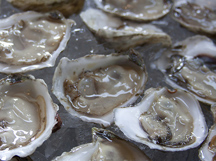Learning Outcomes
When you complete this set of modules you should be able to:
- Explain what is meant by ‘exponential growth’ and generation (doubling) time
- Explain why logarithms are used to plot bacterial growth curves
- Describe the phases of growth in a bacterial culture

The story...
Matt is a university student who likes to travel during his summer holidays. This year he and some friends travelled together to an exotic location for a beach holiday. They were spending their days surfing and eating dinner each night in one of the restaurants scattered along  the beach. Oysters were a specialty of the area and Matt, being a lover of raw oysters, ordered them with his meal whenever they were on the menu. All was going well until one morning he woke up with pains in his stomach. He had to rush to the toilet immediately, and then at regular intervals throughout the day. By the afternoon he was feeling quite weak, as he had lost a lot of fluid.
the beach. Oysters were a specialty of the area and Matt, being a lover of raw oysters, ordered them with his meal whenever they were on the menu. All was going well until one morning he woke up with pains in his stomach. He had to rush to the toilet immediately, and then at regular intervals throughout the day. By the afternoon he was feeling quite weak, as he had lost a lot of fluid.
Luckily there was a small hospital in town so Matt’s friends took him along for a check. Based on Matt’s symptoms of watery diarrhea and vomiting, the doctor suspected cholera and admitted Matt to the hospital. He was placed on a drip to replace all the fluids that he had lost, and the medical staff set to work to trace the source of his infection..
What causes cholera? How many bacteria are needed to make you sick?
 Cholera is caused by Vibrio cholerae, which is a water-borne bacterial pathogen, and, because the disease can kill you, it has been studied extensively. It’s even known how many bacteria you have to ingest to make you ill. This number is called the infective dose (ID), and for most species of Vibrio cholerae the number is approximately 1 million.
Cholera is caused by Vibrio cholerae, which is a water-borne bacterial pathogen, and, because the disease can kill you, it has been studied extensively. It’s even known how many bacteria you have to ingest to make you ill. This number is called the infective dose (ID), and for most species of Vibrio cholerae the number is approximately 1 million.
Matt’s friends have done some searching on the Internet and the main causes of cholera are contaminated water and food. As Matt lies in the hospital with a drip in his arm, he thinks back to what he has eaten and drunk during the last few days. Even though he has never been sick from oysters he has eaten at home, he suspects the oysters, because he has been very careful to only drink bottled water.
 The oysters may have been contaminated by the water in which they were growing, but a million sounds like a lot of bacteria, and he suspects that the bacteria had multiplied in the oysters. After all, the weather was hot and the electricity supply was often cut, so the oysters may have been out of the refrigerator for a while.
The oysters may have been contaminated by the water in which they were growing, but a million sounds like a lot of bacteria, and he suspects that the bacteria had multiplied in the oysters. After all, the weather was hot and the electricity supply was often cut, so the oysters may have been out of the refrigerator for a while.
Matt vaguely remembers from first year biology that bacteria can grow exponentially, but in his current less-than-stellar state, he doesn't quite remember how that works. Let's refresh his memory...
Copyright University of Maryland, 2007
You may link to this site for educational purposes.
Please do not copy without permission
requests/questions/feedback email: mathbench@umd.edu